Stradivari’s Varnish Revisited: Feature Improvements Using Chemical Modification
Abstract
1. Introduction
2. Experimental Section
2.1. Materials
2.2. Methods
2.2.1. Preparation and Application of Varnishes and Other Materials
2.2.2. Instruments and Techniques
2.2.3. NMR Experiments
2.2.4. Artificial Aging of the Samples
3. Results and Discussion
3.1. Preparation of Plain and Modified Stradivari’s Varnishes
3.2. Characterization of Varnish Materials before and after Aging
3.2.1. Optical Microscopy Analyses
3.2.2. FTIR Investigations
3.2.3. TGA and DSC Measurements
3.2.4. NMR Analyses
3.3. Characterization of Coated Wood Specimens
3.3.1. Color Measurements
3.3.2. Contact Angle Measurements
3.3.3. SEM-EDS Experiments
3.3.4. Micro-FTIR Measurements
3.3.5. Pencil Hardness Test
4. Conclusions
Supplementary Materials
Author Contributions
Funding
Institutional Review Board Statement
Data Availability Statement
Acknowledgments
Conflicts of Interest
References
- Echard, J.P.; Benoit, C.; Peris-Vicente, J.; Malecki, V.; Gimeno-Adelantado, J.V.; Vaiedelich, S. Gas chromatography/mass spectrometry characterization of historical varnishes of ancient Italian lutes and violin. Anal. Chim. Acta 2007, 584, 172–180. [Google Scholar] [CrossRef] [PubMed]
- Lammlein, S.; Künniger, T.; Rüggeberg, M.; Schwarze, F.W.M.R.; Mannes, D.; Burgert, I. Frequency dependent mechanical properties of violin varnishes and their impact on vibro-mechanical tonewood properties. Results Mater. 2021, 9, 100137. [Google Scholar] [CrossRef]
- Fiocco, G.; Gonzalez, S.; Invernizzi, C.; Rovetta, T.; Albano, M.; Dondi, P.; Licchelli, M.; Antonacci, F.; Malagodi, M. Compositional and Morphological Comparison among Three Coeval Violins Made by Giuseppe Guarneri “del Gesù” in 1734. Coatings 2021, 11, 884. [Google Scholar] [CrossRef]
- Weththimuni, M.L.; Canevari, C.; Legnani, A.; Licchelli, M.; Malagodi, M.; Ricca, M.; Zeffiro, A. Experimental Characterization of Oil-Colophony Varnishes: A Preliminary Study. Int. J. Conserv. Sci. 2016, 7, 813–826. [Google Scholar]
- Van den Berg, J.D.J. Analytical Chemical Studies on Traditional Linseed Oil Paints. Ph.D. Thesis, University of Amsterdam, Amsterdam, The Netherlands, 2002. Available online: https://pure.uva.nl/ws/files/3716376/20662_Thesis.pdf (accessed on 26 April 2002).
- Juita; Dlugogorski, B.Z.; Kennedy, E.M.; Mackie, J.C. Low temperature oxidation of linseed oil: A review. Fire Sci. Rev. 2012, 1, 3. [Google Scholar] [CrossRef]
- Litwinienko, G. Autooxidation of Unsaturated Fatty Acids and Their Esters. J. Therm. Anal. Calorim. 2001, 65, 639–646. [Google Scholar] [CrossRef]
- Quarantelli, A.; Righi, F.; Renzi, M.; Bonomi, A. Processi ossidativi negli alimenti di origine vegetale. Ann. Fac. Medic. Vet. Di Parma 2003, 23, 181–202. [Google Scholar]
- Lattuati-Derieux, A.; Gomes, S.; Tirat, S.; Thao-Hey, S.; Echard, J.P. New insights into molecular evolution of oil/colophony varnishes: Towards pyrolysis-gas chromatography/mass spectrometry-based quantitation. E-Preserv. Sci. 2014, 11, 54–63. [Google Scholar]
- Daher, C.; Pimenta, V.; Bellot-Gurlet, L. Towards a non-invasive quantitative analysis of the organic components in museum objects varnishes by vibrational spectroscopies: Methological approach. Talanta 2014, 129, 336–345. [Google Scholar] [CrossRef][Green Version]
- Romero-Noguera, J.; Bolívar-Galiano, F.C.; Ramos-López, J.M.; Fernández-Vivas, M.A.; Martín-Sánchez, I. Study of biodegradation of diterpenic varnishes used in art painting: Colophony and Venetian turpentine. Int. Biodeterior. Biodegrad. 2008, 62, 427–433. [Google Scholar] [CrossRef]
- Echard, J.P.; Bertrand, L.; Von Bohlen, A.; Le Hô, A.S.; Paris, C.; Bellot-Gurlet, L.; Soulier, B.; Lattuati-Derieux, A.; Thao, S.; Robinet, L.; et al. The nature of the extraordinary finish of Stradivari’s instruments. Angew. Chem. Int. Ed. Engl. 2010, 49, 197–201. [Google Scholar] [CrossRef]
- Brandmair, B.; Greiner, S.P. (Eds.) Stradivari Varnish: Scientific Analysis of His Finishing Technique on Selected Instruments; Serving Audio: London, UK; Munich, Germany, 2010. [Google Scholar]
- Baraldi, P. Manoscritto Bolognese 2861 (XV Secolo); Biblioteca Universitaria di Bologna: Bologna, Italy, 2012. [Google Scholar]
- Frezzato, F.; Seccaroni, C. Segreti di Arti Diverse nel Regno di Napoli—Manoscritto It. III 10 della Biblioteca Marciana di Venezia; Il Prato: Saonara, Italy, 2010. [Google Scholar]
- Licchelli, M.; Malagodi, M.; Somaini, M.; Weththimuni, M.; Zanchi, C. Surface treatments of wood by chemically modified shellac. Surf. Eng. 2013, 29, 121–127. [Google Scholar] [CrossRef]
- Weththimuni, M.L.; Capsoni, D.; Malagodi, M.; Milanese, C.; Licchelli, M. Shellac/nanoparticles dispersions as protective materials for wood. Appl. Phys. A 2016, 122, 1058–1069. [Google Scholar] [CrossRef]
- Weththimuni, M.L.; Milanese, C.; Licchelli, M.; Malagodi, M. Improving the protective properties of shellac-based varnishes by functionalized nanoparticles. Coatings 2021, 11, 419. [Google Scholar] [CrossRef]
- UNI EN 15886:2010; Conservazione dei Beni Culturali-Metodi di Prova-Misura del Colore Delle Superfici. UNI Ente Italiano di Unificazione: Milan, Italy, 2010.
- UNI EN 15802:2010; Conservazione dei Beni culturali-Metodi di Prova-Determinazione dell’Angolo di Contatto Statico. UNI Ente Italiano di Unificazione: Milan, Italy, 2010.
- ISO 15184:2012; Paints and Varnishes—Determination of Film Hardness by Pencil Test. 2nd ed. International Organization for Standardization: Genève, Switzerland, 2012.
- Weththimuni, M.L.; Capsoni, D.; Malagodi, M.; Licchelli, M. Improving Wood Resistance to Decay by Nanostructured ZnO-Based Treatments. J. Nanomater. 2019, 2019, 6715756. [Google Scholar] [CrossRef]
- Scalarone, D.; Lazzari, M.; Chiantore, O. Ageing behaviour and pyrolytic characterization of diterpenic resins used as art materials: Colophony and Venice turpentine. J. Anal. Appl. Pyrolysis 2002, 64, 345–361. [Google Scholar] [CrossRef]
- Lazzari, M.; Chiantore, O. Drying and oxidative degradation of linseed oil. Polym. Degrad. Stab. 1999, 65, 303–313. [Google Scholar] [CrossRef]
- Spinella, A.; Malagodi, M.; Saladino, M.L.; Weththimuni, M.L.; Caponetti, E.; Licchelli, M. A Step Forward in Disclosing the Secret of Stradivari’s Varnish by NMR Spectroscopy. J. Polym. Sci. Part A Polym. Chem. 2017, 55, 3949–3954. [Google Scholar] [CrossRef]
- Loeblich, V.M.; Lawrence, R.V. Inhibition of Resin Acid Isomerization. Ind. Eng. Chem. 1958, 50, 619. [Google Scholar] [CrossRef]
- Portugal, I.; Vital, J.; Lobo, L.S. Isomerization of Resin Acids during Pine Oleoresin Distillation. Chem. Eng. Sci. 1996, 51, 2577. [Google Scholar] [CrossRef]
- Van den Berg, K.J.; Boon, J.J.; Pastorova, I.; Spetter, L.F.M. Mass spectrometric methodology for the analysis of highly oxidized diterpenoid acids in Old Master paintings. J. Mass Spectr. 2000, 35, 512–533. [Google Scholar] [CrossRef]
- Van den Berg, J.D.J.; Vermist, N.D.; Carlyle, L.; Holcapek, M.; Boon, J.J. Effects of traditional processing methods of linseed oil on the composition of its triacylglycerols. J. Sep. Sci. 2004, 27, 181–199. [Google Scholar] [CrossRef] [PubMed]
- Mallégol, J.; Gardette, J.L.; Lemaire, J. Long-Term Behavior of Oil-Based Varnishes and Paints. Fate of Hydroperoxides in Drying Oils. J. Am. Oil Chem. Soc. 2000, 77, 249–255. [Google Scholar] [CrossRef]
- Mallégol, J.; Gardette, J.L.; Lemaire, J. Long-Term Behavior of Oil-Based Varnishes and Paints I. Spectroscopic Analysis of Curing Drying Oils. J. Am. Oil Chem. Soc. 1999, 76, 967–976. [Google Scholar]
- Zhang, Z.S.; Li, D.; Zhang, L.X. Effect of Heating on the Fatty Acid Composition and Oxidation Products of Flaxseed Oil. Asian J. Chem. 2013, 25, 10082–10086. [Google Scholar] [CrossRef]
- Tirat, S.; Degano, I.; Echard, J.P.; Lattuati-Derieux, A.; Tenorio, A.L.; Marie, A.; Serfaty, S.; Le Huerou, J.Y. Historical linseed oil/colophony varnishes formulations: Study of their molecular composition with micro-chemical chromatographic techniques. Microchem. J. 2016, 126, 200–213. [Google Scholar] [CrossRef]
- Parkin, B.A.; Schuller, W.H.; Lawrence, R.V. Thermal dimerization of rosin. Ind. Eng. Chem. Prod. Res. Dev. 1969, 8, 304–306. [Google Scholar] [CrossRef]
- Frances, M.; Gardere, Y.; Rubini, M.; Duret, E.; Leroyer, L.; Cabaret, T.; Bi Athomo, A.B.; Charrier, B. Effect of heat treatment on Pinus pinaster rosin: A study of physico chemical changes and influence on the quality of rosin linseed oil varnish. Ind. Crops Prod. 2020, 155, 112789. [Google Scholar] [CrossRef]
- Chin, K.M.; Ting, S.S.; Ong, H.L.; Omar, M. Surface functionalized nanocellulose as a veritable inclusionary material in contemporary bioinspired applications. A review. J. Appl. Polym. Sci. 2018, 135, 46065. [Google Scholar] [CrossRef]
- Schramm, C. High temperature ATR-FTIR characterization of the interaction of polycarboxylic acids and organotrialkoxysilanes with cellulosic material. Spectroch. Acta A Mol. Biomol. Spectrosc. 2020, 243, 118815. [Google Scholar] [CrossRef]
- Sirisinha, K.; Chimdist, S. Comparison of techniques for determining crosslinking in silane-water crosslinked materials. Polym. Test. 2006, 25, 518–526. [Google Scholar] [CrossRef]
- Weththimuni, M.; Crivelli, F.; Galimberti, C.; Malagodi, M.; Licchelli, M. Evaluation of commercial consolidating agents on very porous biocalcarenite. Int. J. Conserv. Sci. 2020, 11, 251–260. [Google Scholar]
- Weththimuni, M.L.; Ben Chobba, M.; Sacchi, D.; Messaoud, M.; Licchelli, M. Durable Polymer Coatings: A Comparative Study of PDMS-Based Nanocomposites as Protective Coatings for Stone Materials. Chemistry 2022, 4, 60–76. [Google Scholar] [CrossRef]
- Burunkaya, E.; Kiraz, N.; Kesmez, O.; Asilturk, M.; Camurlu, H.E.; Arpaç, E. Sol–gel synthesis of IPTES and D10H consisting fluorinated silane system for hydrophobic applications. J. Solgel Sci. Technol. 2010, 56, 99–106. [Google Scholar] [CrossRef]
- Alessi, S.; Caponetti, E.; Güven, O.; Akbulut, M.; Spadaro, G.; Spinella, A. Study of the curing process of DGEBA epoxy resin through structural investigation. Macromol. Chem. Phys. 2015, 216, 538–546. [Google Scholar] [CrossRef]
- Weththimuni, M.; Ben Chobba, M.; Tredici, I.; Licchelli, M. ZrO2-Doped ZnO-PDMS Nanocomposites as Protective Coatings for the Stone Materials. Acta IMEKO 2022, 11, 5. [Google Scholar] [CrossRef]
- Ben Chobba, M.; Weththimuni, M.L.; Messaoud, M.; Bouaziz, J.; Salhi, R.; Leo, F.D.; Urzi, C.; Licchelli, M. Silver-Doped TiO2-PDMS Nanocomposite as a Possible Coating for the Preservation of Serena Stone: Searching for Optimal Application Conditions. Heritage 2022, 5, 3411–3426. [Google Scholar] [CrossRef]
- Chobba, M.B.; Weththimuni, M.L.; Messaoud, M.; Urzi, C.; Bouaziz, J.; de Leo, F.; Licchelli, M. Ag-TiO2/PDMS nanocomposite protective coatings: Synthesis, characterization, and use as a self-cleaning and antimicrobial agent. Prog. Org. Coat. 2021, 158, 106342. [Google Scholar] [CrossRef]
- Ben Chobba, M.; Weththimuni, M.L.; Messaoud, M.; Sacchi, D.; Bouaziz, J.; Leo, F.D.; Urzi, C.; Licchelli, M. Multifunctional and Durable Coatings for Stone Protection Based on Gd-Doped Nanocomposites. Sustainability 2021, 13, 11033. [Google Scholar] [CrossRef]

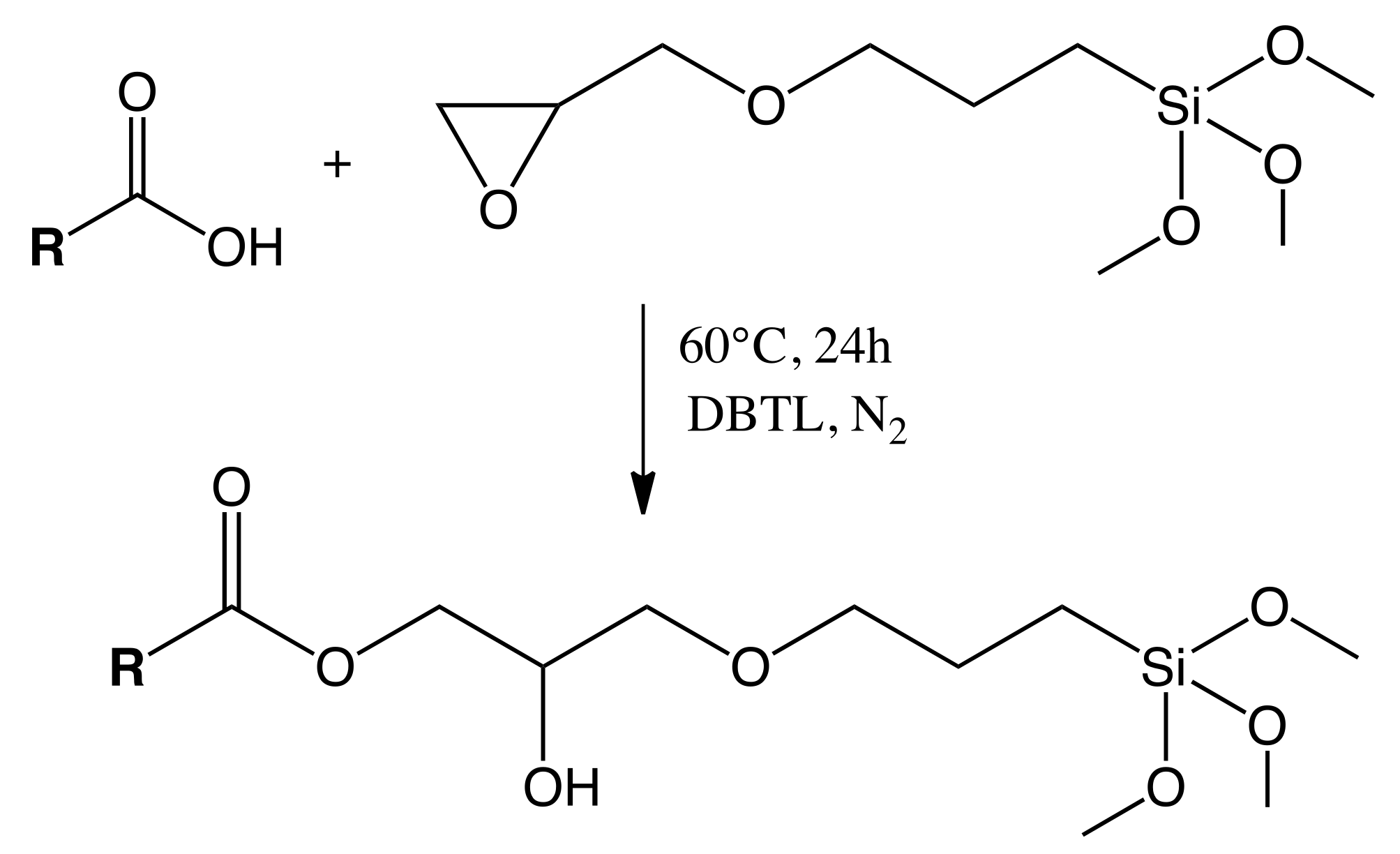


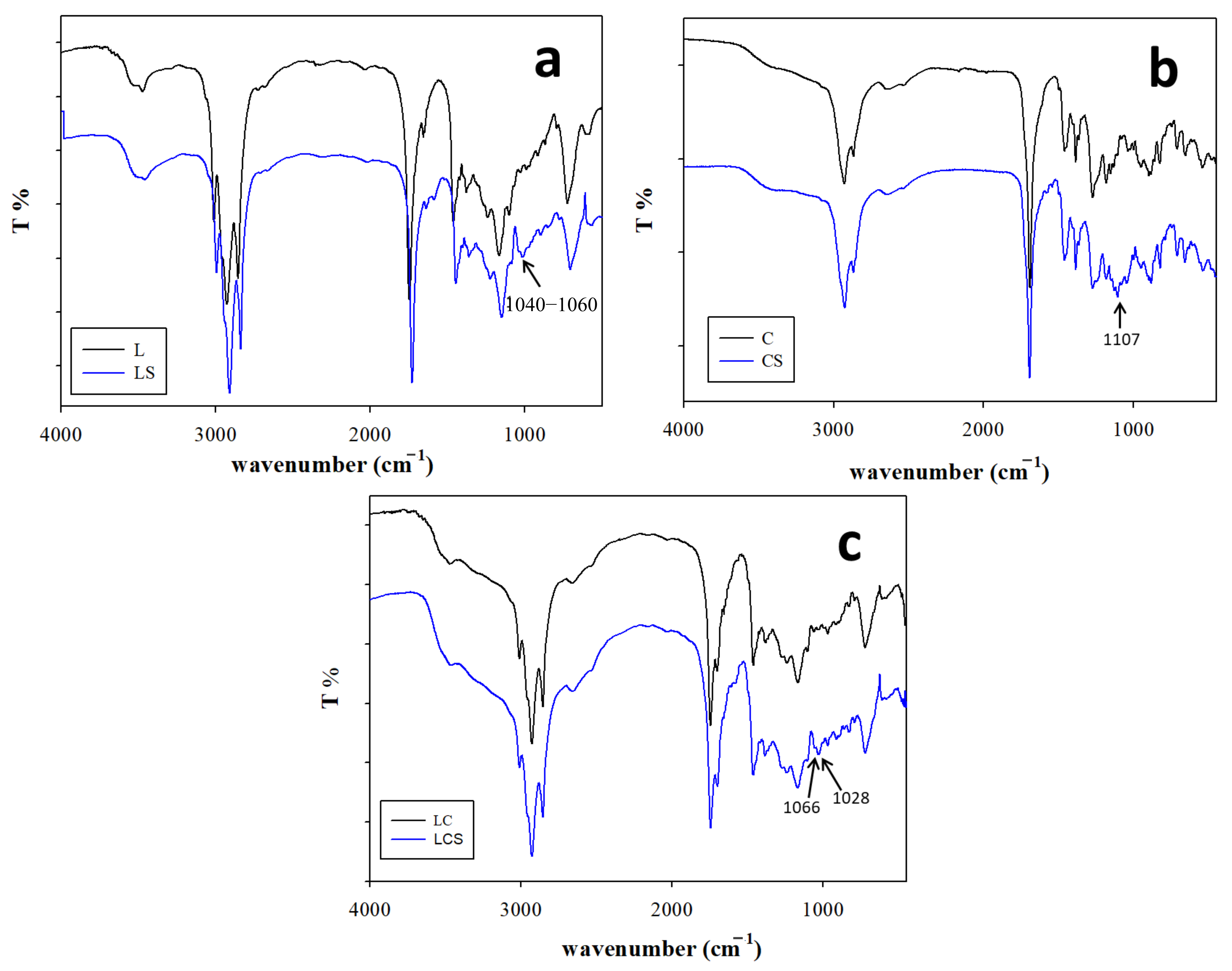
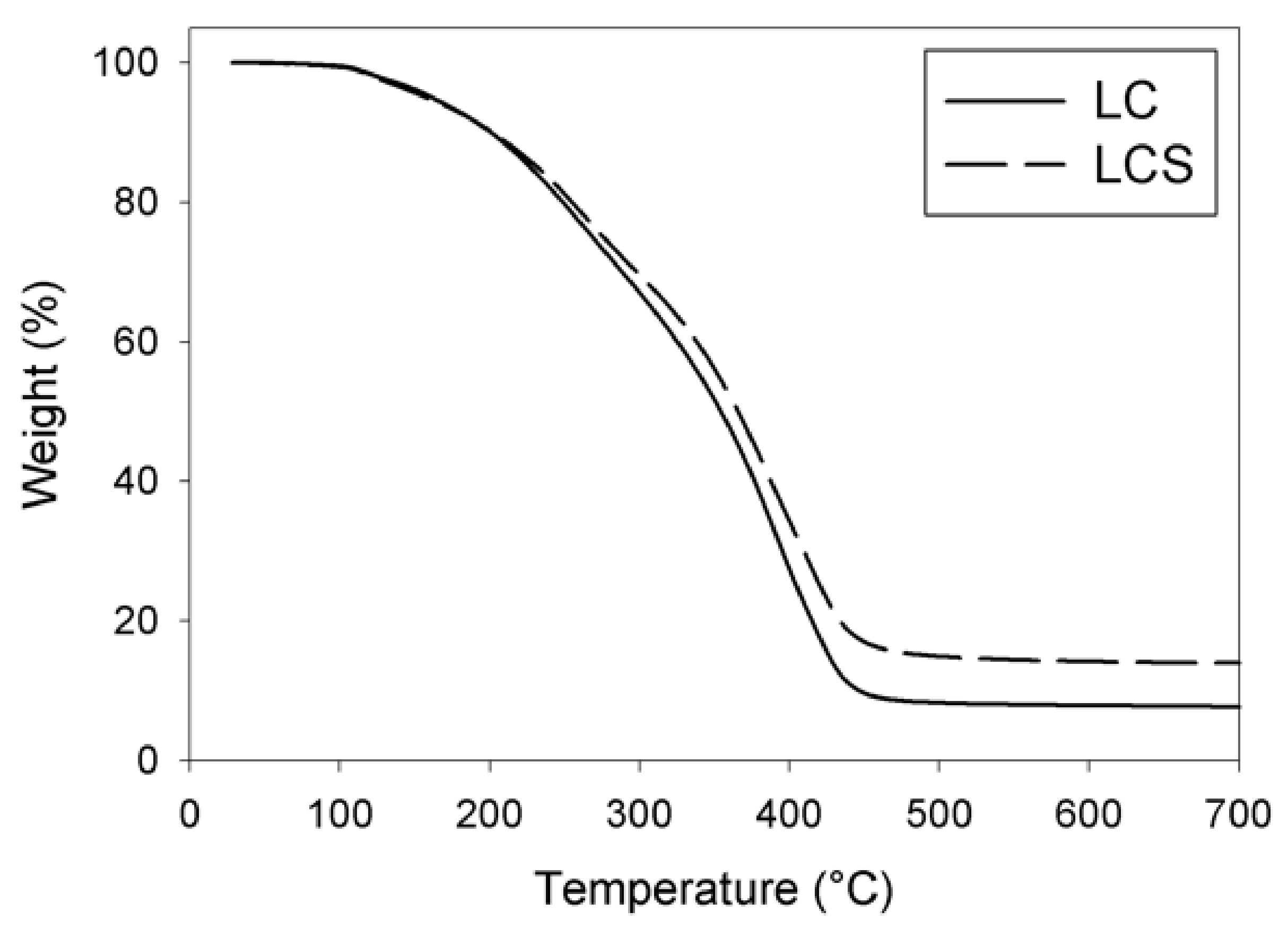

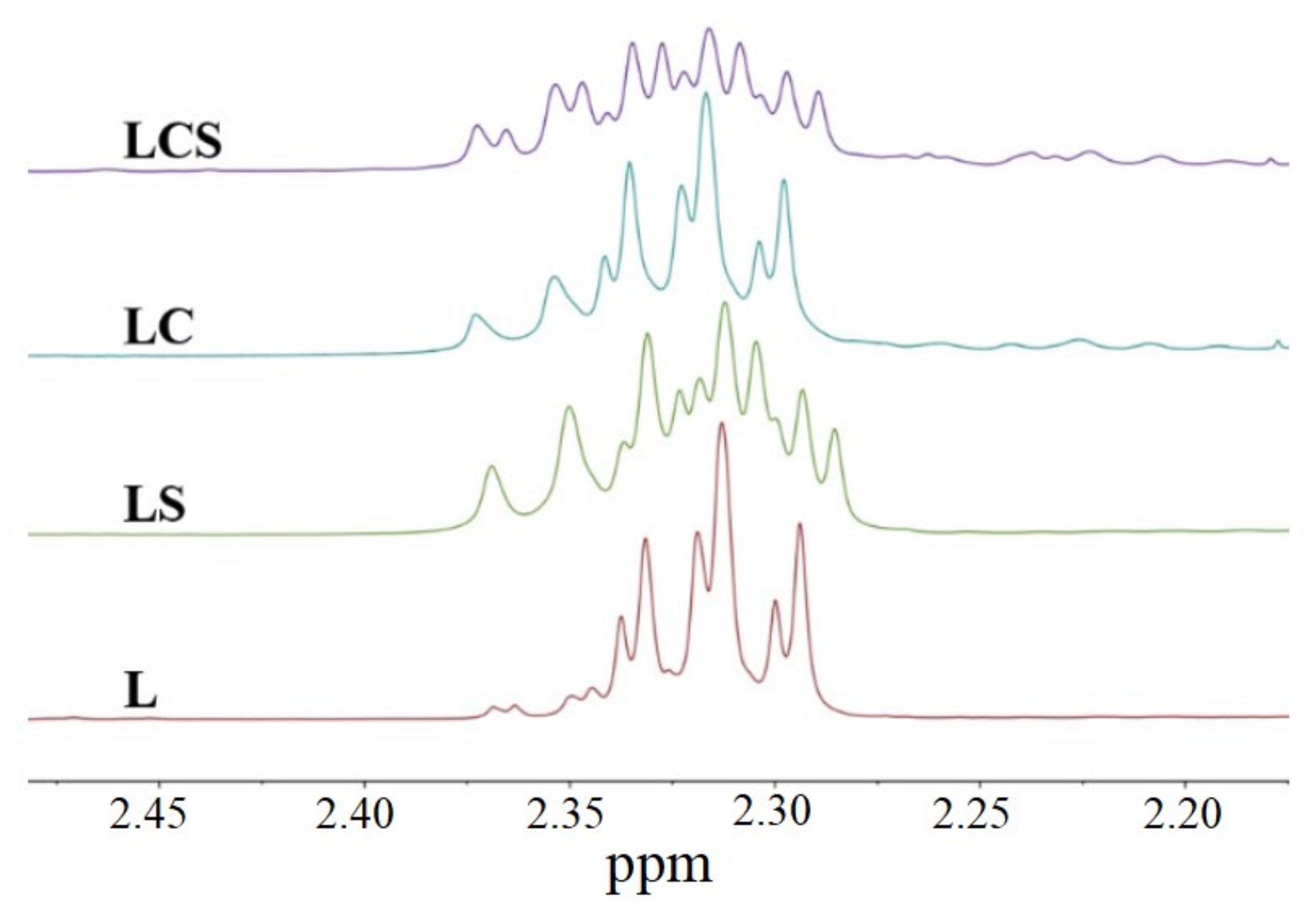

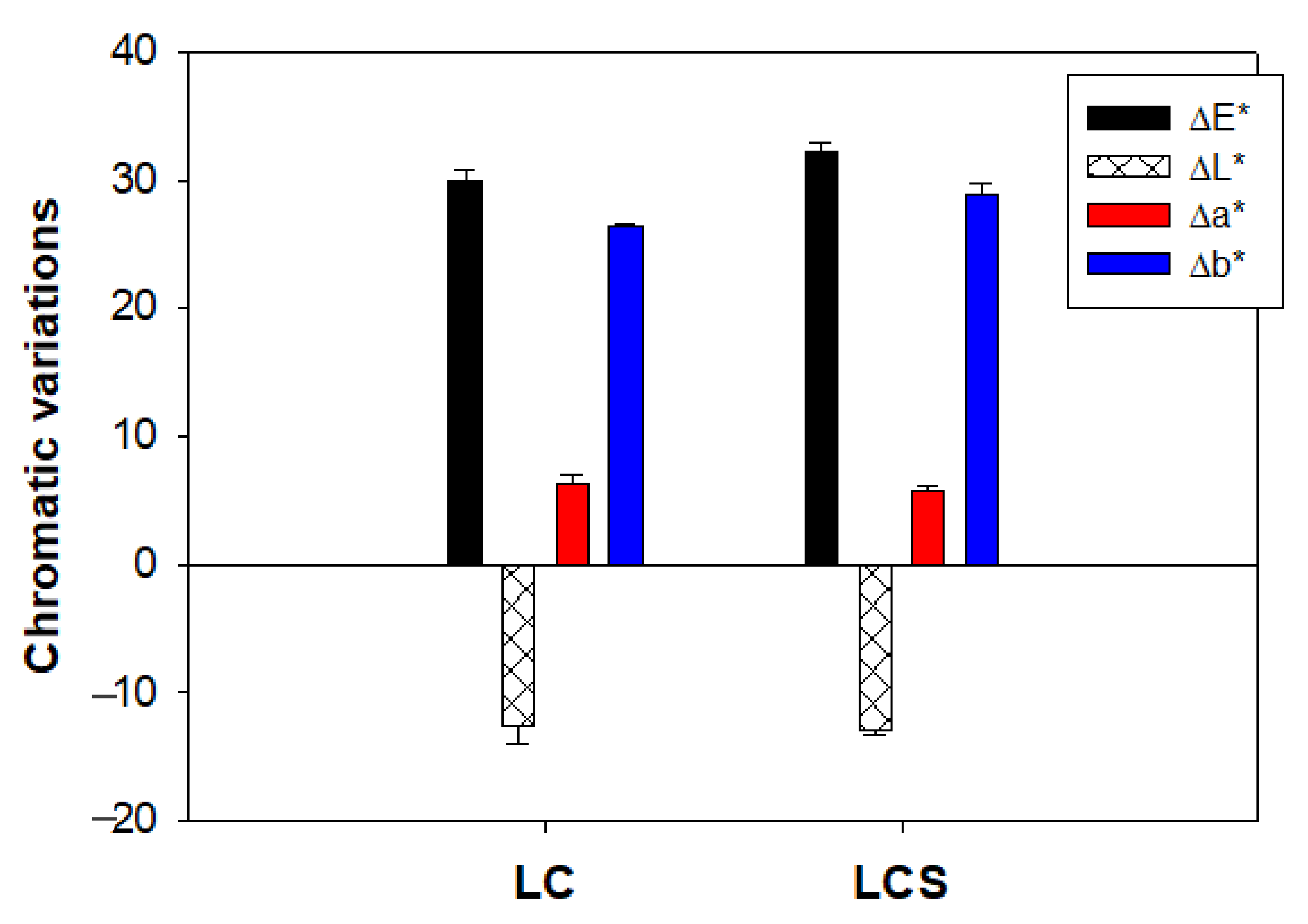
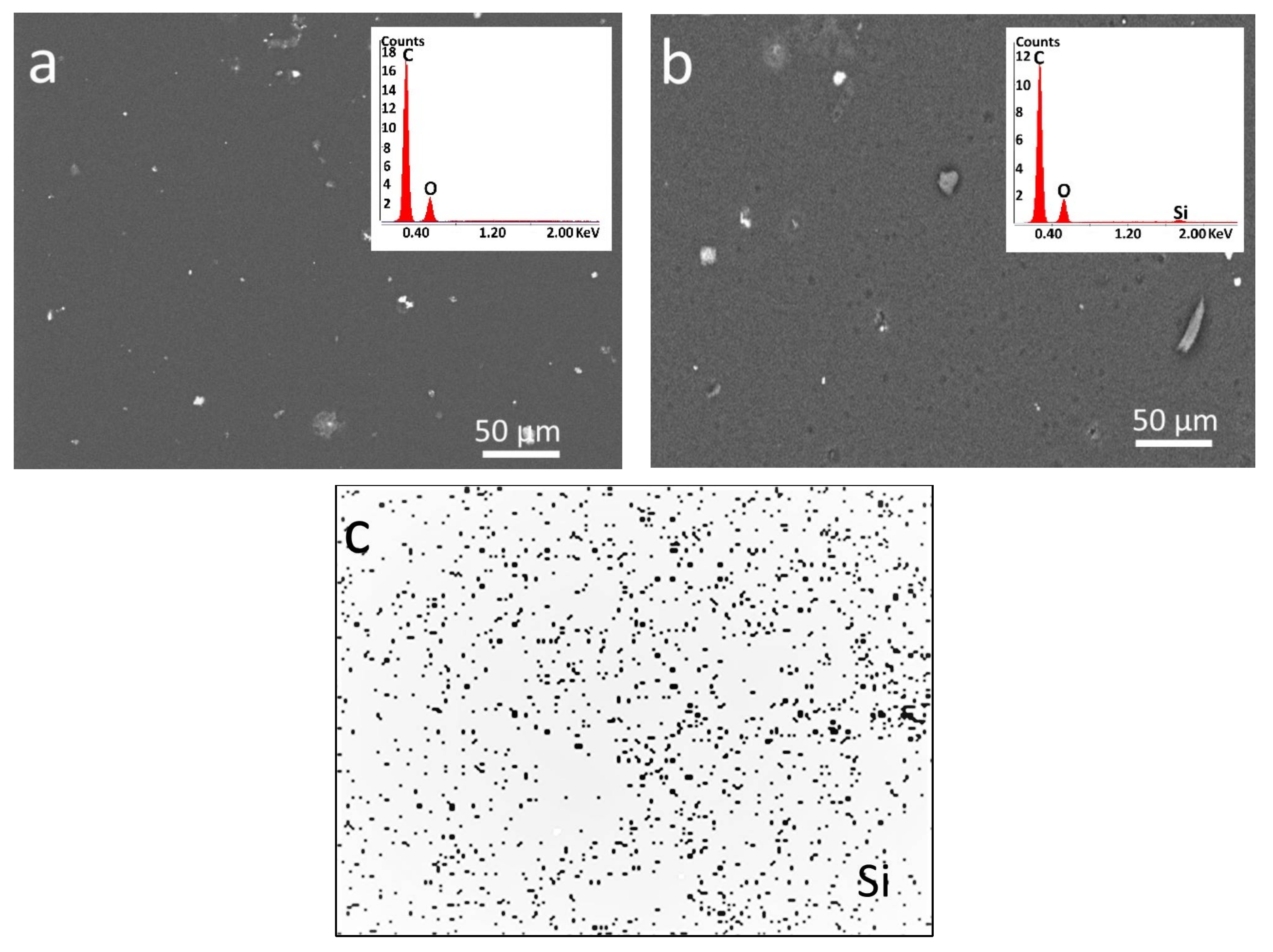
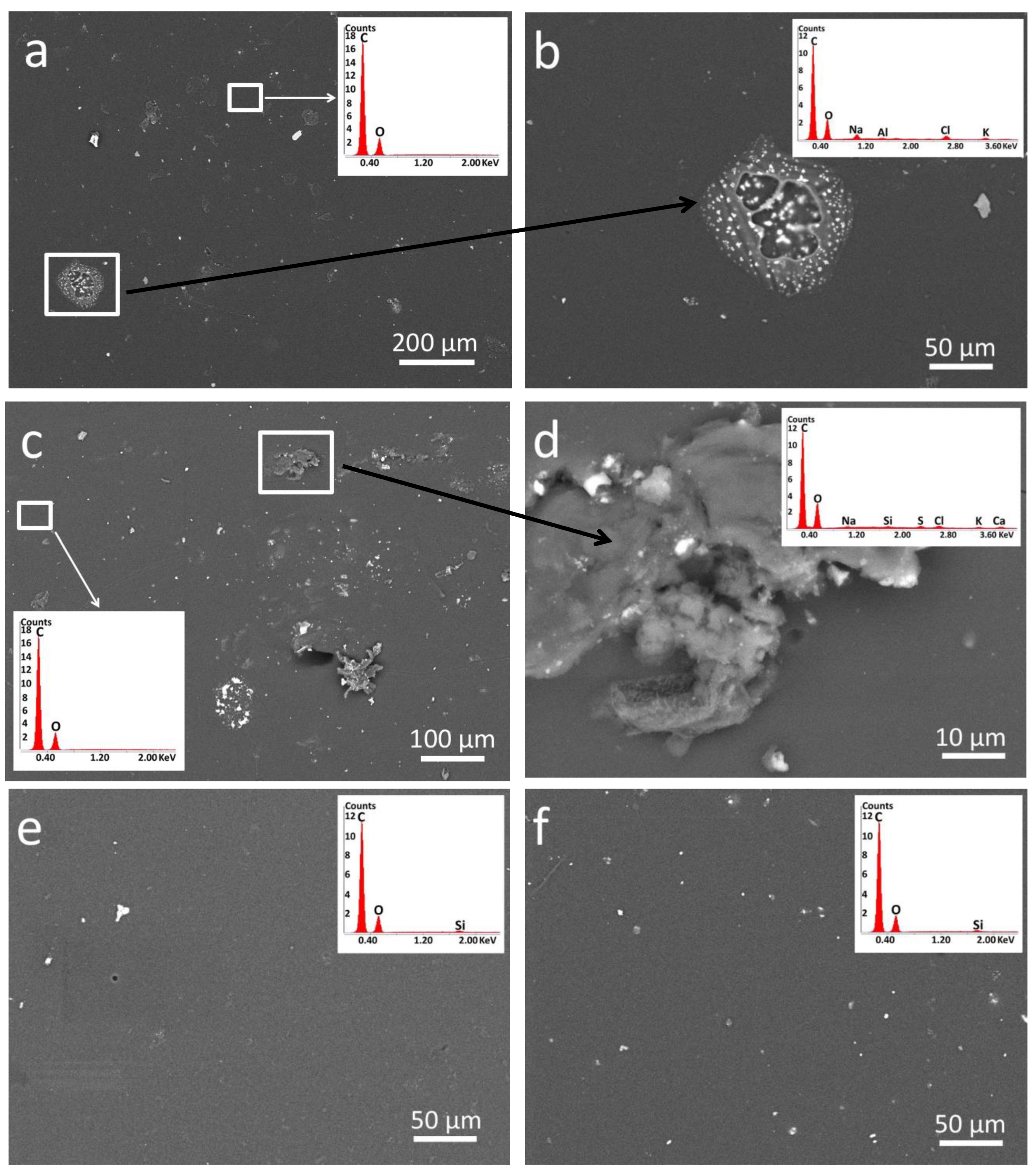

| Films | Tg (°C) |
|---|---|
| Pure linseed oil (L) | −6.8 |
| Functionalized linseed oil (LS) | 31.5 |
| Colophony (C) | 60 |
| Functionalized colophony (CS) | 75 |
| Varnish LC | 17.4 |
| Varnish LC after UV aging (LC_UV) | −28.3 |
| Varnish LC after thermal aging (LC_T) | −26.2 |
| Varnish LCS | 40.3 |
| Varnish LCS after UV aging (LCS_UV) | 33.5 |
| Varnish LCS after thermal aging (LCS_T) | 25.5 |
| Samples | LC | LCS | LC | LCS |
|---|---|---|---|---|
| Ppm | T1ρH (ms) | T1ρC (ms) | ||
| 38 (colophony) | 0.9 ± 0.1 | 1.3 ± 0.1 | 6.4 ± 0.1 | 9.6 ± 0.1 |
| 30 (oil) | 0.8 ± 0.1 | 1.2 ± 0.1 | 2.3 ± 0.1 | 3.8 ± 0.1 |
| Samples | UV-Aged (720 h) | Heat/Humidity-Aged (720 h) | ||||||
|---|---|---|---|---|---|---|---|---|
| ΔE* | ΔL* | Δa* | Δb* | ΔE* | ΔL* | Δa* | Δb* | |
| Varnish LC | 21.9 (±5.8) | −9.1 (±5.5) | 8.1 (±2.6) | 18.0 (±3.1) | 23.5 (±0.4) | −5.9 (±1.2) | 6.0 (±0.9) | 21.9 (±0.2) |
| Varnish LCS | 11.9 (±2.3) | −5.5 (±2.9) | 4.8 (±0.8) | 9.2 (±1.3) | 15.2 (±0.1) | −9.7 (±0.2) | 9.3 (±0.3) | 6.9 (±0.5) |
| Samples | Before Aging | UV-Aged | Heat/Humidity-Aged |
|---|---|---|---|
| (720 h) | (720 h) | ||
| Varnish LC | 98.5 (±8.0) | 86.6 (±6.0) | 82.0 (±2.7) |
| Varnish LCS | 132.5 (±3.8) | 110.8 (±1.6) | 110.3 (±7.2) |
| Samples | After Treatments | UV-Aged | Thermal-Aged |
|---|---|---|---|
| Varnish LC | B | 3B-2B | 4B-3B |
| Varnish LCS | H | F | HB |
Disclaimer/Publisher’s Note: The statements, opinions and data contained in all publications are solely those of the individual author(s) and contributor(s) and not of MDPI and/or the editor(s). MDPI and/or the editor(s) disclaim responsibility for any injury to people or property resulting from any ideas, methods, instructions or products referred to in the content. |
© 2023 by the authors. Licensee MDPI, Basel, Switzerland. This article is an open access article distributed under the terms and conditions of the Creative Commons Attribution (CC BY) license (https://creativecommons.org/licenses/by/4.0/).
Share and Cite
Weththimuni, M.L.; Fiocco, G.; Milanese, C.; Spinella, A.; Saladino, M.L.; Malagodi, M.; Licchelli, M. Stradivari’s Varnish Revisited: Feature Improvements Using Chemical Modification. Polymers 2023, 15, 3652. https://doi.org/10.3390/polym15173652
Weththimuni ML, Fiocco G, Milanese C, Spinella A, Saladino ML, Malagodi M, Licchelli M. Stradivari’s Varnish Revisited: Feature Improvements Using Chemical Modification. Polymers. 2023; 15(17):3652. https://doi.org/10.3390/polym15173652
Chicago/Turabian StyleWeththimuni, Maduka L., Giacomo Fiocco, Chiara Milanese, Alberto Spinella, Maria Luisa Saladino, Marco Malagodi, and Maurizio Licchelli. 2023. "Stradivari’s Varnish Revisited: Feature Improvements Using Chemical Modification" Polymers 15, no. 17: 3652. https://doi.org/10.3390/polym15173652
APA StyleWeththimuni, M. L., Fiocco, G., Milanese, C., Spinella, A., Saladino, M. L., Malagodi, M., & Licchelli, M. (2023). Stradivari’s Varnish Revisited: Feature Improvements Using Chemical Modification. Polymers, 15(17), 3652. https://doi.org/10.3390/polym15173652










